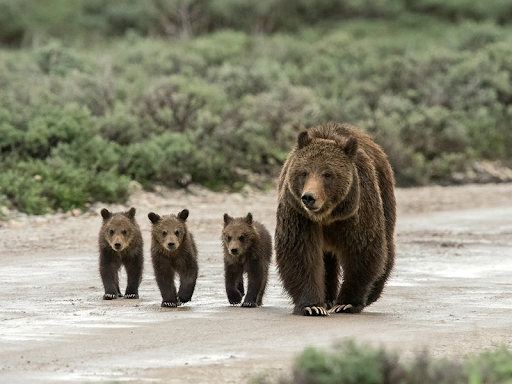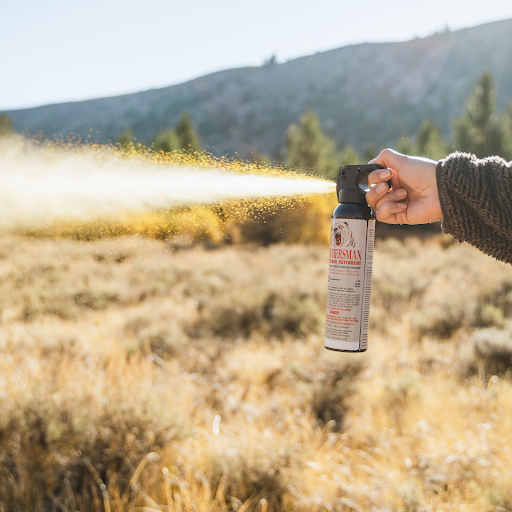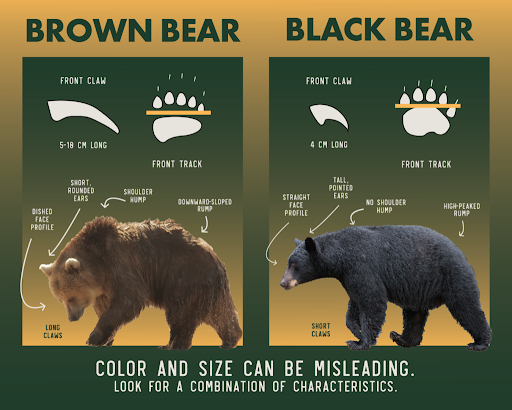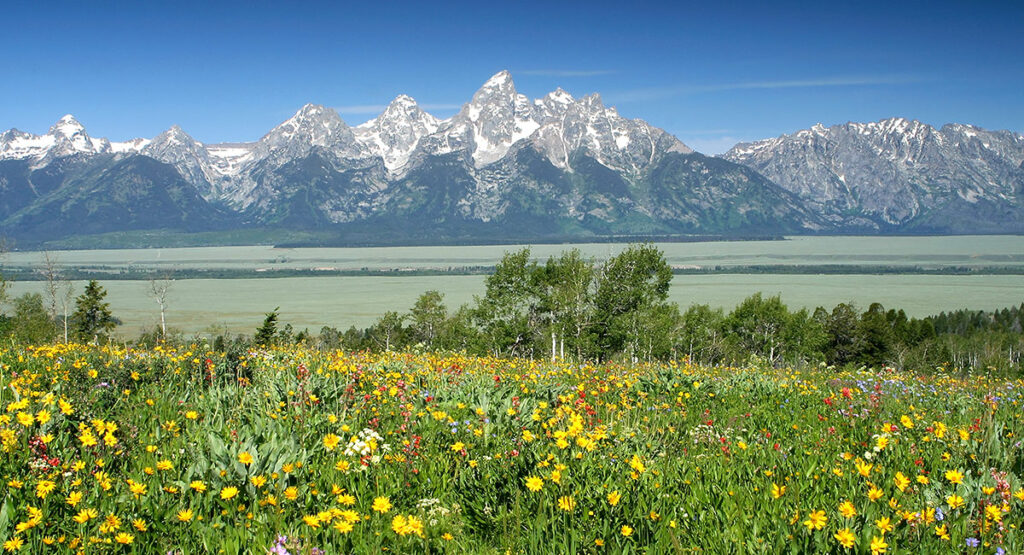Bear Safety on Jackson Hole Trails
If you see a bear in Teton County it is both an amazing experience AND a potentially dangerous encounter—especially if you’re in the backcountry! Before your next trail run, hike, bike, or ski (yes you can still run into bears in the winter), make sure you know the necessary bear facts and safety tips.
Bears in Jackson Hole
Jackson Hole is located in the greater yellowstone ecosystem—one of the largest intact temperate ecosystems in the world. Besides the geysers, mountains, and flowering meadows, you can witness the fascinating animals that inhabit this area. Black bears and brown bears (grizzlies) are two animals that you can encounter while you’re recreating here. Although you may be more likely to see a bear in Grand Teton National Park, they are still prevalent in the Bridger-Teton National Forest, Caribou-Targhee National Forest, and on Bureau of Land Management areas in Teton County. Wherever you are—be bear aware.
Yellowstone area researchers documented more than 260 species of plants and animals that bears in this area can consume. Because of their wide appetites, bears travel long distances to eat roots, berries, insects, grasses, fish, small game animals, and large game animals. Toward the late summer and early fall, bears increase the amount of food they consume to prepare for winter hibernation. As a result, you could encounter a bear on nearly any trail we have here. So, how do you avoid an unpleasant encounter with a hungry bear or even more dangerous—a mama bear?

How to prepare for an unexpected bear encounter in Jackson Hole
#1: Carry Bear Spray
Bear spray, bear spray, bear spray. Need we say it again?
Bear Spray is a type of intense pepper spray intended for use on an aggressive and charging bear. It is much more potent than regular pepper spray and should only be deployed in extreme situations.
- Know how to use bear spray (check the directions)
- Don’t spray your clothes or equipment with it (this is a great way to end up in the hospital for eye irritation/damage)
- Bring bear spray with you on every trail (buy bear spray from a local store or rent one)
Even though bear spray can be bulky and awkward, it’s a necessary item. Just like you need water, snacks, sunscreen, and a first aid kit—bring bear spray. Use a carabiner and attach it to your running vest, hiking pack, or any other safe place. Make sure that it’s easy to access in the event of a surprise bear encounter.
#2: Recreate in groups
Hiking in groups of three or more SIGNIFICANTLY reduces the chance of a bear attack. The more the merrier in bear country!
#3: Make noise on the trails
Bears can act aggressively if they are startled. So, make noise on the trails. Alert bears to your presence and they will generally try to avoid you. Talk, sing, or clap your hands. Making noise on the trail is especially important if you’re near loud natural features like streams or rivers where a bear can’t hear you or on densely vegetated trails where a bear can’t see you from far away.
#4: Be aware of bear presence
Keep an eye out for any indication that a bear is close by—fresh tracks, scat, carcasses, claw marks on trees, and rolled over logs. Some trailheads include updated information on recent bear activity. Check the trailhead signs before you start.
#5: Leave your dog at home or keep them leashed
To bears, dogs can be more threatening than humans. Dogs look more like wolves and are likely to chase after a bear— a recipe for disaster in bear country.
- Dogs are not permitted on trails in Grand Teton National Park.
- Check the trailhead information in the national forest for dog-related rules. Dogs may need to be leashed on popular trails.
#6: Try to stay 100 yards away
Although this isn’t always possible when you unexpectedly encounter a bear on a trail, try to stay 100 yards away. The 100 yard rule applies to both bears and wolves in our area.
What to do if you encounter a bear on a trail
The previously mentioned preventive measures should help you stay safe in bear country. However, some bear encounters will be unavoidable while you use the local trails. If you come in close contact with a bear here are a few tips to keep you safe.
DO NOT RUN
Bears are an apex predator with a chase instinct. If they see something run then they have the natural instinct to chase it. If you’re face to face with a bear do this:
- Back away slowly—don’t make any sudden movements
- Talk in a slow low voice
- Avoid direct eye contact
Bears are faster than humans so you can’t outrun them. Climbing a tree doesn’t work either because even grizzlies can outclimb humans.

Sow and cub encounters
If you encounter a sow and cub make sure that you exercise extreme caution.
- Never get between a mama and her cub
- If you see a hurt or struggling cub—DO NOT APPROACH IT
Warning signs that you’re too close to a bear
Bears give some warning signs that they’re nervous or distressed—sticking out their tongues, slapping the ground with their paws, and having their head down and ears pointed back.
Any bear can be dangerous
Although grizzlies tend to be more aggressive than black bears, take extreme precaution around both. Black bears have attacked and killed humans as well.
What to do if there’s an aggressive bear on the trail
Even if you’re taking all the right precautions, some bears may still be aggressive. They could do one of two charges:
- Bluff charge: This is when a bear runs at you but doesn’t intend to hurt you—rather to scare or intimidate you. It may run at you but then bound away and/or stand up to make itself look bigger. Hold your ground and stay calm. Back away slowly.
- Aggressive charge: This is the dangerous charge when a bear intends to do harm. This is when you need to protect and defend yourself! Bear spray was designed for this type of charge. Now’s the time to use it.
According to the National Park Service, you should act in two different ways depending on whether you’re aggressively charged by a brown bear (grizzly) or a black bear.
Grizzly Charge – Play dead and don’t fight back. Grizzlies will often leave you alone if they think that you’re not a threat anymore. Lay down on your stomach, spread your legs apart, and keep your pack on to protect your back. Keep quiet and wait until the bear walks away to get up.
Black Bear Charge – Fight back! Black bears can be scared off when you give direct punches or kicks to the face. You could even use things around you like branches or rocks to defend yourself.
If you are charged or notice other aggressive bear behavior you can reach out to the appropriate authorities. In Grand Teton National Park you can contact a ranger and for other locations you should get in touch with the Wyoming Game and Fish warden.
Have a positive bear experience on Jackson Hole Trails
Although some of this information may seem daunting or scary, most hikers, bikers, runners, and skiers have positive bear encounters on our trails. Bears WANT to avoid humans in almost every situation. While we hope that you never have to use this information it is still SO important to know in bear country. Enjoy the wildlife, have a blast on the trails, and stay safe!




